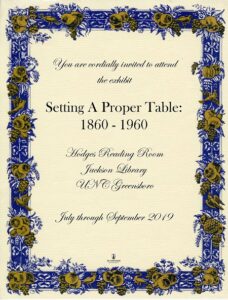
“Setting a Proper Table: 1860-1960”
“There’s something special about gathering a few favorite people for a meal. A beautifully set table is the perfect canvas for a delicious meal.”
Chantal Larocque
An elegantly set table is more than a backdrop for a good meal, it can also reflect social status, proper etiquette, and cultural traditions. Seemingly minute details, such as the placement of utensils, reflected important aspects of the meal, from the status of the guests to the dishes being served.
The Victorian era in Britain saw a growing interest in table settings, a trend which was soon reflected in American society as well. With the rise of the middle class, many families were in a financial position to entertain, and purchased expensive crystal, china, silver, and ivory. The purpose was to closely emulate the upper class and nobility who populated their table with as many intricate service pieces as possible, requiring a knowledge of etiquette that would reflect their social station. Meals were served in “courses” (a la russe), allowing more space at the table for elegant china, utensils, and floral arrangements. The quality and quantity of serving pieces reflected the host’s wealth and station. The lower classes’ tables had plates made of wood and pottery, while the upper classes purchased fine china and employed silversmiths and craftsman to create sumptuous table settings.
Floral arrangements enhanced the tableware and in some cases decorators were brought in to install “artificial gardens” to delight guests. Dinner parties became popular and American tables were set with European tableware. Books were published by authors, such as Mrs. Isabella Beeton, to help the lady of the house keep up with table manners and settings.
Table settings became less extravagant in the years following World War I, as house staff diminished, and women moved progressively into the workforce. This trend would continue through the next war, as advances in household appliances and prepackaged meals required less extravagant table settings. Increasingly, the focus was to simplify – leaving more elaborate table settings to holidays and special occasions.
This exhibit, “Setting a Proper Table: 1860-1960,” features china and silver that would have been seen on tables from 1860 to 1960.